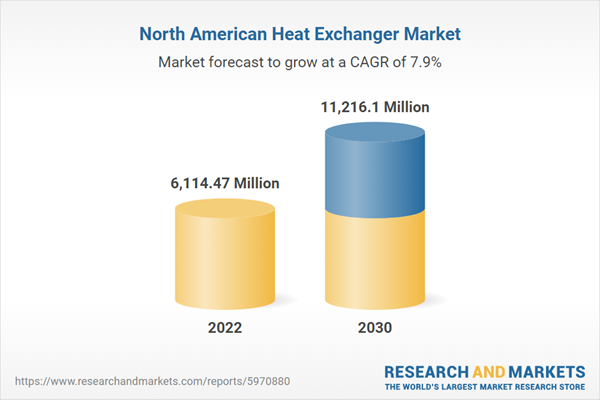Use of Heat Exchangers in Oil & Gas Industry Fuel the North America Heat Exchanger Market
According to the report published by the International Energy Agency (IEA) in June 2023, the global demand for oil is expected to grow by 6% from 2022 to 2028 and will reach up to 105.7 million barrels per day (mb/d) in 2028. The demand is growing due to the rising requirement for petrochemicals and the increasing need for oil in the aviation sector. In addition, the investments for the upstream segment in oil and gas exploration, extraction, and production are anticipated to reach their highest value since 2015 and are projected to grow by 11% year-on-year to US$ 528 billion in 2023. In addition, the investment and expansion in the refineries is increasing due to the rise in oil and gas demand. Therefore, the rise in global oil demand and investment in the oil & gas industry contributes to the production of oil and gas, where heat exchangers are used to eliminate the heat generated during production. It helps maintain the rapid generation or dissipation of heat to enhance productivity in the oil & gas industry. These heat exchangers are used in various applications such as heat/oil transfer systems, fuel gas conditioning systems, cold ammonia flow control, lube oil systems, and selective catalytic reduction (SCR) units. For example, in fuel gas conditioning systems, the heat exchanger helps maintain the heat generated during the steady flow of dry, high-purity fuel and ensures system components are working in stable conditions for a long period. In the lube oil system, heat exchangers help to provide an optimal thermal environment for the smooth operation of critical components such as mixers, kettles, and electrical switchgear. Thus, with the growth in the oil & gas industry, the use of heat exchangers is increasing, which is driving the market.North America Heat Exchanger Market Overview
The North America heat exchanger market is segmented into the US, Canada, and Mexico. The region is adopting hydropower electricity generation as it is one of the clean sources of energy and is developing power plants to meet the growing energy demand. For instance, according to the US Department of Energy report for January 2021, the hydropower capacity increased by a net of 431 MW in 2019 since 2017. The capacity was increased from existing facilities, new facilities, and powering non-powered dams (NPDs), which resulted in a total net growth of 1,688 MW from 2010 to 2019. In addition, Mexico is planning to build many gas-fired power plants to increase the natural gas supply, including importing natural gas from the US. For instance, in November 2022, US-based New Fortress Energy announced the deal signed with the Mexican government to develop the LNG project Lakach offshore gas field in Mexico, which is expected to be completed by 2024. Thus, these plants generate the need for heat exchangers for gas drying, preheating natural gas, and liquefaction of natural gas in LNG plants. In the hydropower plant, heat exchangers minimize the downtime of turbines, generators, and transformers by reducing the heat generated. Thus, the rising establishment of hydropower plants contributes to the North America heat exchanger market growth.North America Heat Exchanger Market Segmentation
The North America heat exchanger market is segmented based on type, material, application, and country. Based on type, the North America heat exchanger market is segmented into shell and tube, plate and frame, air cooled, and others. The shell and tube segment held the largest market share in 2022.Based on material, the North America heat exchanger market is segmented into steel, copper, and others. The steel segment held the largest market share in 2022.
Based on application, the North America heat exchanger market is segmented into energy, chemical, food and beverages, HVACR, pulp and paper, and others. The energy segment held the largest market share in 2022.
Based on country, the North America heat exchanger market is segmented into the US, Canada, and Mexico. The US dominated the North America heat exchanger market share in 2022.
Alfa Laval AB, API Heat Transfer Inc, Chart Industries Inc, Danfoss AS, Guntner GmbH & Co KG, Johnson Controls International Plc, Kelvion Holding GmbH, Larsen & Toubro Ltd, and Xylem Inc are some of the leading companies operating in the North America heat exchanger market.
Table of Contents
Companies Mentioned (Partial List)
A selection of companies mentioned in this report includes, but is not limited to:
- Alfa Laval AB
- API Heat Transfer Inc
- Chart Industries Inc
- Danfoss AS
- Guntner GmbH & Co KG
- Johnson Controls International Plc
- Kelvion Holding GmbH
- Larsen & Toubro Ltd
- Xylem Inc
Table Information
| Report Attribute | Details |
|---|---|
| No. of Pages | 92 |
| Published | March 2024 |
| Forecast Period | 2022 - 2030 |
| Estimated Market Value in 2022 | 6114.47 Million |
| Forecasted Market Value by 2030 | 11216.1 Million |
| Compound Annual Growth Rate | 7.9% |
| Regions Covered | North America |









